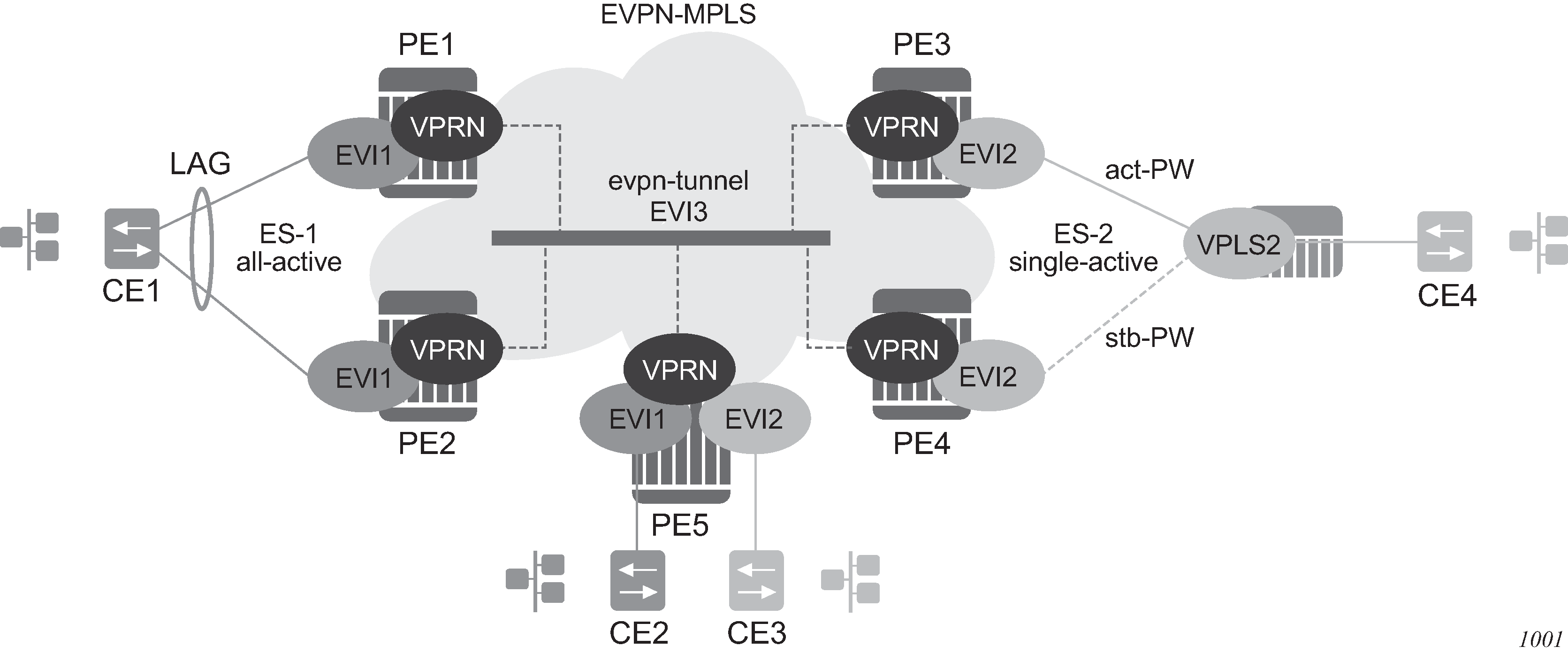SAP and spoke SDP based ESs are supported on R-VPLS services where bgp-evpn mpls is enabled.
Figure 1 shows an example of EVPN-MPLS multi-homing in R-VPLS services, with the following assumptions.
There are two subnets for a specific customer (for example, EVI1 and EVI2 in Figure 1), and a VPRN is instantiated in all the PEs for efficient inter-subnet forwarding.
A ‟backhaul” R-VPLS with evpn-tunnel mode enabled is used in the core to interconnect all the VPRNs. EVPN IP-prefix routes are used to exchange the prefixes corresponding to the two subnets.
An all-active ES is configured for EVI1 on PE1 and PE2.
A single-active ES is configured for EVI2 on PE3 and PE4.

In the example in Figure 1, the hosts connected to CE1 and CE4 could use regular VRRP for default gateway redundancy; however, this may not be the most efficient way to provide upstream routing.
For example, if PE1 and PE2 are using regular VRRP, the upstream traffic from CE1 may be hashed to the backup IRB VRRP interface, instead of being hashed to the active interface. The same thing may occur for single-active multi-homing and regular VRRP for PE3 and PE4. The traffic from CE4 is sent to PE3, while PE4 may be the active VRRP router. In that case, PE3 has to send the traffic to PE4, instead of route it directly.
In both cases, unnecessary bandwidth between the PEs is used to get to the active IRB interface. In addition, VRRP scaling is limited if aggressive keepalive timers are used.
Because of these issues, passive VRRP is recommended as the best method when EVPN-MPLS multi-homing is used in combination with R-VPLS redundant interfaces.
Passive VRRP is a VRRP setting in which the transmission and reception of keepalive messages is completely suppressed, and therefore the VPRN interface always behaves as the active router. Passive VRRP is enabled by adding the passive keyword to the VRRP instance at creation, as shown in the following examples:
config service vprn 1 interface int-1 vrrp 1 passive
config service vprn 1 interface int-1 ipv6 vrrp 1 passive
For example, if PE1, PE2, and PE5 in Figure 1 use passive VRRP, even if each individual R-VPLS interface has a different MAC/IP address, because they share the same VRRP instance 1 and the same backup IP, the three PEs own the same virtual MAC and virtual IP address (for example, 00-00-5E-00-00-01 and 10.0.0.254). The virtual MAC is auto-derived from 00-00-5E-00-00-VRID per RFC 3768. The following is the expected behavior when passive VRRP is used in this example.
All R-VPLS IRB interfaces for EVI1 have their own physical MAC/IP address; they also own the same default gateway virtual MAC and IP address.
All EVI1 hosts have a unique configured default gateway; for example, 10.0.0.254.
When CE1 or CE2 send upstream traffic to a remote subnet, the packets are routed by the closest PE because the virtual MAC is always local to the PE.
For example, the packets from CE1 hashed to PE1 are routed at PE1. The packets from CE1 hashed to PE2 are routed directly at PE2.
Downstream packets (for example, packets from CE3 to CE1), are routed directly by the PE to CE1, regardless of the PE to which PE5 routed the packets.
For example, the packets from CE3 sent to PE1 are routed at PE1. The packets from CE3 sent to PE2 are routed at PE2.
In case of ES failure in one of the PEs, the traffic is forwarded by the available PE.
For example, if the packets routed by PE5 arrive at PE1 and the link to CE1 is down, then PE1 sends the packets to PE2. PE2 forwards the packets to CE1 even if the MAC source address of the packets matches PE2's virtual MAC address. Virtual MACs bypass the R-VPLS interface MAC protection.
The following list summarizes the advantages of using passive VRRP mode versus regular VRRP for EVPN-MPLS multi-homing in R-VPLS services.
Passive VRRP does not require multiple VRRP instances to achieve default gateway load-balancing. Only one instance per R-VPLS, therefore only one default gateway, is needed for all the hosts.
The convergence time for link/node failures is not impacted by the VRRP convergence, as all the nodes in the VRRP instance are acting as active routers.
Passive VRRP scales better than VRRP, as it does not use keepalive or BFD messages to detect failures and allow the backup to take over.